When opening a retail store, restaurant or cafe, choosing the right point of sale (POS) system is essential. It will determine how you run your business.
This article will compare two major POS system providers: Lightspeed and Shopify.
Point of Sale (POS)
Lightspeed POS is integrated with our e-commerce platform, while Shopify POS is a separate product built on the Shopify e-commerce platform. Lightspeed POS supports brick-and-mortar, online, and multichannel sales.
Lightspeed POS includes a traditional cash register with a touchscreen interface; Shopify POS is an iPad app designed for mobility.
Inventory Management
Like everything else, Lightspeed has a more robust inventory management system than Shopify. While both platforms offer basic inventory management features that allow you to track items in your store and keep track of your inventory, Lightspeed’s inventory management tools go further.
For example, suppose an item is sold out in one of your stores and customers no longer have the option to purchase it (because the product is no longer available).
In that case, you can use Lightspeed’s “Mark as Unavailable” feature so that those products no longer appear on your site until they become available again through another sale or a reorder from the manufacturer or retailer. Unfortunately, Shopify does not yet offer this feature (but plans to add it).
Reports & Analytics
Shopify
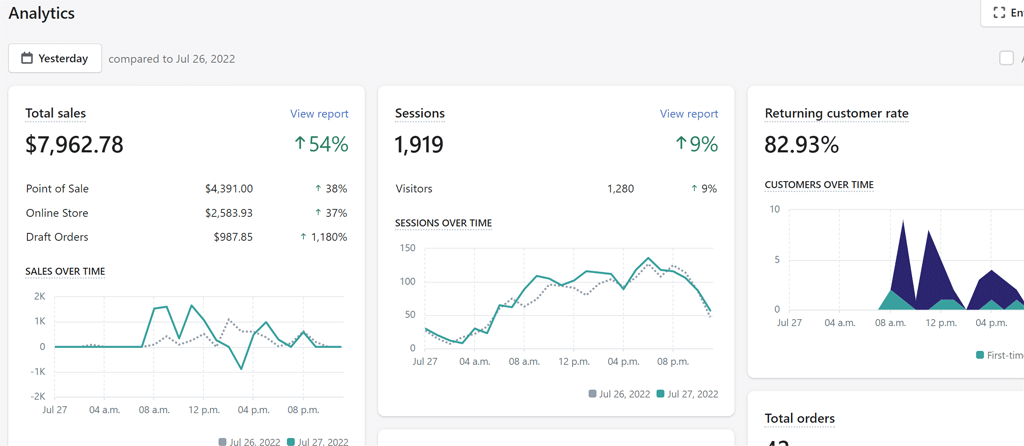
Shopify’s reporting and analytics features are robust and helpful. For example, Shopify Plus customers can see how long a customer stayed on the site, what pages they visited, and where customers came from. But even if you have the Shopify or Advanced subscriptions you will be provided with enough information to stick around for as long as you want.
Lightspeed
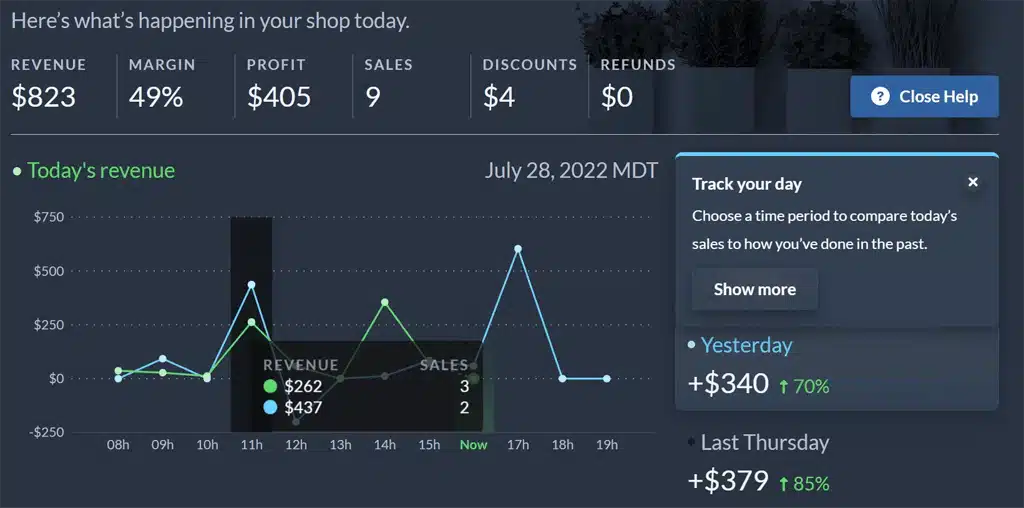
Lightspeed offers extensive and detailed reports for all users to get a better overview of your sales performance over time. You can also see which products are selling well together when you create bundles or use upselling tactics to increase sales through repeat purchases (more on these tactics below).
Integrations
Shopify
Shopify integrations are possible with the help of third-party apps. These apps can be installed onto a website or a blog, and they will work seamlessly with Shopify.
Apps like these are very helpful for small business owners who don’t have enough time to manage their website or blog as well as their online store.
Shopify has an integration with Google Adwords that lets you link your Adwords account to your Shopify store. With this integration, you can easily transfer data between the two platforms and automate certain tasks.
Lightspeed
Lightspeed offers a variety of integrations, including Amazon and eBay, Google Analytics, Magento, PayPal, Shopify (to pull product data), and more. Additionally, if you use an e-commerce platform other than WooCommerce or BigCommerce – both are supported by Lightspeed – you can connect your site to Lightspeed via the API.
E-Commerce

What’s the difference between Lightspeed and Shopify? When it comes to e-commerce, both platforms are fully integrated with their e-commerce software. In addition, both offer a variety of apps for different functions, such as accounting and marketing. However, there are some key differences.
Lightspeed’s integrated platform is more advanced than Shopify’s. For example, Lightspeed offers multiple ways to view your store data (including by-products), while Shopify provides only one way. Meaning that Lightspeed may be a better fit for your business needs if you’re making customizations or have specific requirements for your data organization, such as viewing all orders from a particular customer.
Channel Management
Lightspeed and Shopify are similar in the way they handle channel management. Both platforms allow you to manage your inventory, channels, and customers in one place.
Customer Support
Lightspeed has its own customer support team, while Shopify’s customer support is automated. Lightspeed also provides a phone number and email address for customers to contact with questions or issues, while Shopify offers a forum for users to interact with each other.
Pricing
Shopify
Lightspeed is more expensive than Shopify. However, the differences in pricing are minimal: Shopify’s basic package costs $29 per month, but with Shopify, you get much more. This includes an online store that lets you sell your products without having to install any software on your computer and many apps that let you customize your checkout process or add shipping options.

However, in addition to these apps and the base package price, there are fees for sales transactions you make through your storefront – with Canadian online credit card fees of 2.9% + 30¢ CAD plus third-party transaction fees of 2% if you don’t use Shopify Payments.
Lightspeed
Lightspeed’s pricing structure is similar: there are three tiers based on the features you need in each tier. Like Shopify, which offers a 14-day free trial, Lightspeed offers a 14-day free trial with unlimited access to all features, no credit card required. In addition, both platforms offer a 30-day money-back guarantee if users are unsatisfied with either service within the first few weeks.
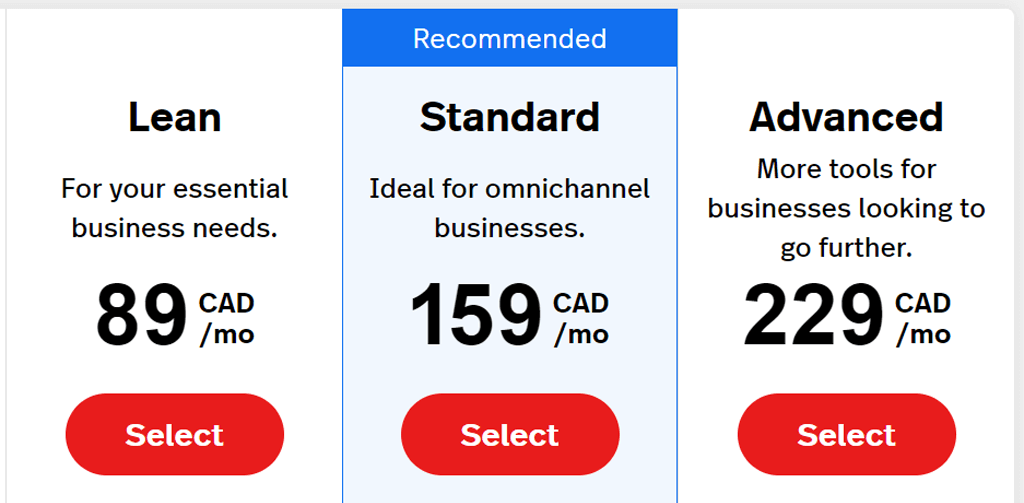
Lightspeed is ideal for multichannel retailers, while Shopify has a large app ecosystem.
If you’re an established multichannel retailer looking to focus your business primarily on e-commerce, Lightspeed is your platform. The impressive reporting features and top-notch integrations make Lightspeed a powerful choice. Unfortunately, Shopify doesn’t offer many third-party apps (although it has its own).
Conclusion
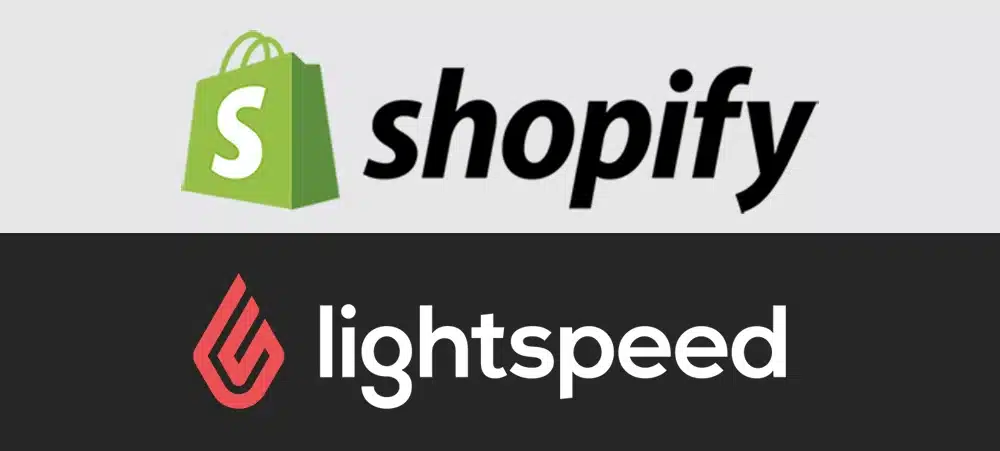
Lightspeed and Shopify are both solid POS systems that can take your business to the next level.
However, it’s important to remember that these two platforms have very different strengths, so you need to think carefully about your needs before making a decision about which system is right for you.
For example, Lightspeed offers all-in-one integration with multiple eCommerce channels, making it the ideal solution for multichannel merchants. On the other hand, Shopify has a vast ecosystem of apps in its App Store that allow users to add unique features and integrations to their store to fit almost any need imaginable – but this system doesn’t always play well with third-party POS systems.
Still, both platforms offer compelling features like inventory management and customer service tools that make them an excellent choice for small businesses looking to one day become larger enterprises!
Call or email us today and we’ll take your Lightspeed website or Shopify website to the next level in user satisfaction and increased revenue.
Shopify vs. Lightspeed
When opening a retail store, restaurant or cafe, choosing the right point of sale (POS) system is essential. It will determine how you run your business.
This article will compare two major POS system providers: Lightspeed and Shopify.
Point of Sale (POS)
Lightspeed POS is integrated with our e-commerce platform, while Shopify POS is a separate product built on the Shopify e-commerce platform. Lightspeed POS supports brick-and-mortar, online, and multichannel sales.
Lightspeed POS includes a traditional cash register with a touchscreen interface; Shopify POS is an iPad app designed for mobility.
Inventory Management
Like everything else, Lightspeed has a more robust inventory management system than Shopify. While both platforms offer basic inventory management features that allow you to track items in your store and keep track of your inventory, Lightspeed’s inventory management tools go further.
For example, suppose an item is sold out in one of your stores and customers no longer have the option to purchase it (because the product is no longer available).
In that case, you can use Lightspeed’s “Mark as Unavailable” feature so that those products no longer appear on your site until they become available again through another sale or a reorder from the manufacturer or retailer. Unfortunately, Shopify does not yet offer this feature (but plans to add it).
Reports & Analytics
Shopify

Shopify’s reporting and analytics features are robust and helpful. For example, Shopify Plus customers can see how long a customer stayed on the site, what pages they visited, and where customers came from. But even if you have the Shopify or Advanced subscriptions you will be provided with enough information to stick around for as long as you want.
Lightspeed

Lightspeed offers extensive and detailed reports for all users to get a better overview of your sales performance over time. You can also see which products are selling well together when you create bundles or use upselling tactics to increase sales through repeat purchases (more on these tactics below).
Integrations
Lightspeed
Lightspeed offers a variety of integrations, including Amazon and eBay, Google Analytics, Magento, PayPal, Shopify (to pull product data), and more. Additionally, if you use an e-commerce platform other than WooCommerce or BigCommerce – both are supported by Lightspeed – you can connect your site to Lightspeed via the API.
Shopify
Shopify integrations are possible with the help of third-party apps. These apps can be installed onto a website or a blog, and they will work seamlessly with Shopify.
Apps like these are very helpful for small business owners who don’t have enough time to manage their website or blog as well as their online store.
Shopify has an integration with Google Adwords that lets you link your Adwords account to your Shopify store. With this integration, you can easily transfer data between the two platforms and automate certain tasks.
E-Commerce

What’s the difference between Lightspeed and Shopify? When it comes to e-commerce, both platforms are fully integrated with their e-commerce software. In addition, both offer a variety of apps for different functions, such as accounting and marketing. However, there are some key differences.
Lightspeed’s integrated platform is more advanced than Shopify’s. For example, Lightspeed offers multiple ways to view your store data (including by-products), while Shopify provides only one way. Meaning that Lightspeed may be a better fit for your business needs if you’re making customizations or have specific requirements for your data organization, such as viewing all orders from a particular customer.
Channel Management
Lightspeed and Shopify are similar in the way they handle channel management. Both platforms allow you to manage your inventory, channels, and customers in one place.
Customer Support
Lightspeed has its own customer support team, while Shopify’s customer support is automated. Lightspeed also provides a phone number and email address for customers to contact with questions or issues, while Shopify offers a forum for users to interact with each other.
Pricing
Shopify
Lightspeed is more expensive than Shopify. However, the differences in pricing are minimal: Shopify’s basic package costs $29 per month, but with Shopify, you get much more. This includes an online store that lets you sell your products without having to install any software on your computer and many apps that let you customize your checkout process or add shipping options.

However, in addition to these apps and the base package price, there are fees for sales transactions you make through your storefront – with Canadian online credit card fees of 2.9% + 30¢ CAD plus third-party transaction fees of 2% if you don’t use Shopify Payments.
Lightspeed
Lightspeed’s pricing structure is similar: there are three tiers based on the features you need in each tier. Like Shopify, which offers a 14-day free trial, Lightspeed offers a 14-day free trial with unlimited access to all features, no credit card required. In addition, both platforms offer a 30-day money-back guarantee if users are unsatisfied with either service within the first few weeks.

Lightspeed is ideal for multichannel retailers, while Shopify has a large app ecosystem.
If you’re an established multichannel retailer looking to focus your business primarily on e-commerce, Lightspeed is your platform. The impressive reporting features and top-notch integrations make Lightspeed a powerful choice. Unfortunately, Shopify doesn’t offer many third-party apps (although it has its own).
Conclusion
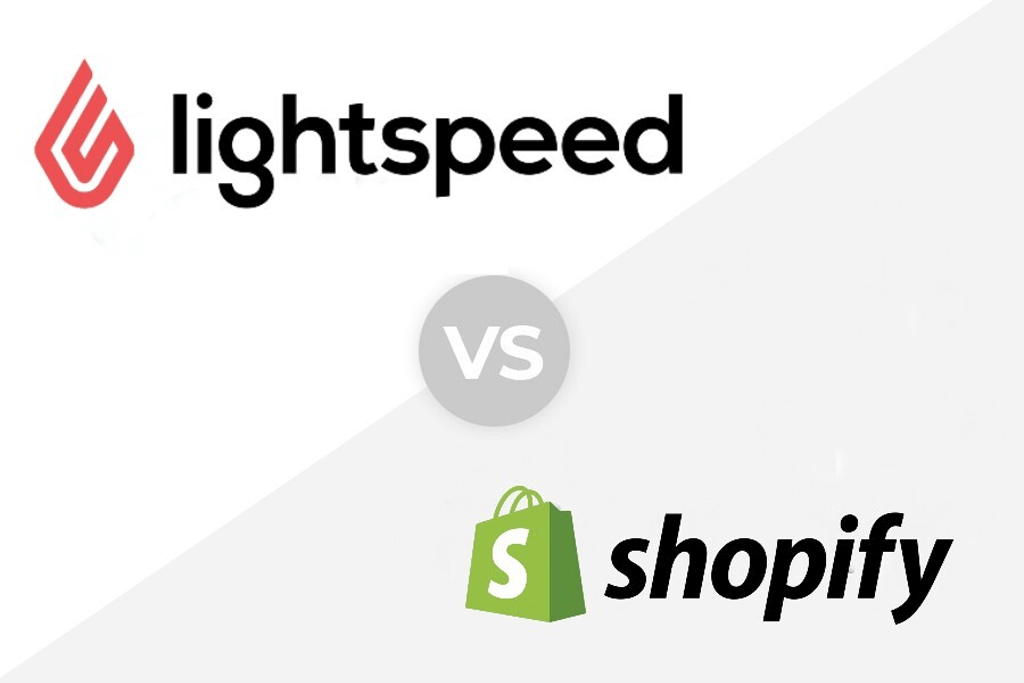
Lightspeed and Shopify are both solid POS systems that can take your business to the next level.
However, it’s important to remember that these two platforms have very different strengths, so you need to think carefully about your needs before making a decision about which system is right for you.
For example, Lightspeed offers all-in-one integration with multiple eCommerce channels, making it the ideal solution for multichannel merchants. On the other hand, Shopify has a vast ecosystem of apps in its App Store that allow users to add unique features and integrations to their store to fit almost any need imaginable – but this system doesn’t always play well with third-party POS systems.
Still, both platforms offer compelling features like inventory management and customer service tools that make them an excellent choice for small businesses looking to one day become larger enterprises!
Call or email us today and we’ll take your Lightspeed website or Shopify website to the next level in user satisfaction and increased revenue.
